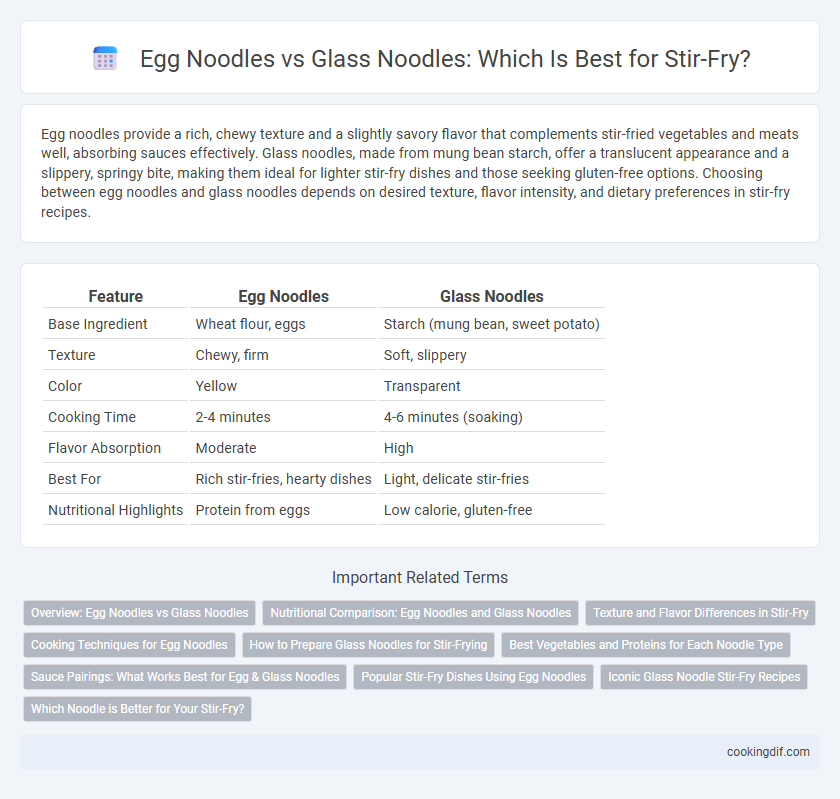Egg noodles provide a rich, chewy texture and a slightly savory flavor that complements stir-fried vegetables and meats well, absorbing sauces effectively. Glass noodles, made from mung bean starch, offer a translucent appearance and a slippery, springy bite, making them ideal for lighter stir-fry dishes and those seeking gluten-free options. Choosing between egg noodles and glass noodles depends on desired texture, flavor intensity, and dietary preferences in stir-fry recipes.
Table of Comparison
| Feature | Egg Noodles | Glass Noodles |
|---|---|---|
| Base Ingredient | Wheat flour, eggs | Starch (mung bean, sweet potato) |
| Texture | Chewy, firm | Soft, slippery |
| Color | Yellow | Transparent |
| Cooking Time | 2-4 minutes | 4-6 minutes (soaking) |
| Flavor Absorption | Moderate | High |
| Best For | Rich stir-fries, hearty dishes | Light, delicate stir-fries |
| Nutritional Highlights | Protein from eggs | Low calorie, gluten-free |
Overview: Egg Noodles vs Glass Noodles
Egg noodles, made from wheat flour and eggs, offer a chewy texture and rich flavor ideal for stir-fry dishes needing a hearty base. Glass noodles, derived from mung bean starch or sweet potato starch, provide a translucent appearance and a light, slippery texture that absorbs sauces well without overpowering other ingredients. Both noodles vary significantly in cooking time and compatibility with different stir-fry sauces, influencing the overall dish profile.
Nutritional Comparison: Egg Noodles and Glass Noodles
Egg noodles contain more protein and fat due to their wheat flour and egg composition, providing approximately 7 grams of protein and 2.5 grams of fat per 100 grams. Glass noodles, made primarily from mung bean starch or sweet potato starch, offer fewer calories and almost zero fat but lack significant protein, averaging around 85 calories and less than 1 gram of protein per 100 grams. For stir-fry dishes, egg noodles deliver higher protein and energy content, while glass noodles serve as a low-fat, low-calorie alternative suitable for lighter meals.
Texture and Flavor Differences in Stir-Fry
Egg noodles offer a chewy and springy texture that holds up well in stir-fry, providing a rich, savory flavor due to their wheat and egg content. Glass noodles, made from mung bean starch, present a slippery, slightly chewy consistency with a neutral taste that absorbs the flavors of the sauce and other ingredients. In stir-fry dishes, egg noodles contribute a hearty mouthfeel and robust taste, while glass noodles deliver a lighter, more translucent texture that complements delicate flavors.
Cooking Techniques for Egg Noodles
Egg noodles require boiling until al dente before stir-frying to maintain their texture and prevent sogginess. After draining, tossing them briefly in oil helps keep strands separate during high-heat cooking. Stir-frying over medium-high heat with vegetables and protein ensures even coating and optimal flavor absorption without breaking the noodles.
How to Prepare Glass Noodles for Stir-Frying
Glass noodles require soaking in warm water for 10 to 15 minutes until pliable before stir-frying, ensuring they retain a chewy texture without becoming mushy. Drain thoroughly and toss with a bit of oil to prevent sticking during cooking. Unlike egg noodles, glass noodles absorb sauces quickly, making them ideal for flavorful stir-fry dishes that emphasize light, translucent strands.
Best Vegetables and Proteins for Each Noodle Type
Egg noodles, known for their rich texture and slightly chewy bite, pair exceptionally well with vegetables like bell peppers, carrots, and snap peas, along with proteins such as chicken, beef, and shrimp that absorb their savory flavors. Glass noodles, prized for their translucent, delicate nature, complement lighter vegetables like bok choy, mushrooms, and bean sprouts, while seafood and tofu provide subtle protein options that enhance their smooth consistency. Choosing the right vegetables and proteins for each noodle type elevates stir-fry dishes by balancing texture and flavor, maximizing both nutritional value and culinary satisfaction.
Sauce Pairings: What Works Best for Egg & Glass Noodles
Egg noodles absorb rich, savory sauces like soy-based or hoisin blends, enhancing stir-fry dishes with their slightly chewy texture. Glass noodles pair exceptionally well with lighter, fragrant sauces such as garlic, ginger, and chili-infused dressings, complementing their translucent and slippery consistency. Choosing the right sauce intensifies the unique qualities of each noodle, ensuring a balanced and flavorful stir-fry.
Popular Stir-Fry Dishes Using Egg Noodles
Egg noodles are favored in popular stir-fry dishes like chow mein and lo mein due to their chewy texture and ability to absorb rich sauces. Unlike glass noodles, which are translucent and slippery, egg noodles hold up well under high heat, maintaining their bite and enhancing stir-fry flavors. These characteristics make egg noodles a staple in many Asian-inspired stir-fry recipes, providing both substance and taste.
Iconic Glass Noodle Stir-Fry Recipes
Glass noodles, made from mung bean starch, offer a transparent, chewy texture that absorbs stir-fry sauces well, contrasting with the denser, egg-enriched texture of egg noodles. Iconic glass noodle stir-fry recipes often feature ingredients like shrimp, garlic, soy sauce, and vegetables, highlighting the noodles' ability to soak up bold, savory flavors while maintaining a light bite. Their gluten-free nature and quick cooking time make glass noodles a versatile and healthier alternative for stir-fry dishes compared to traditional egg noodles.
Which Noodle is Better for Your Stir-Fry?
Egg noodles provide a rich, chewy texture that absorbs sauces well, making them ideal for hearty stir-fry dishes. Glass noodles, made from mung bean starch, offer a translucent, slippery consistency that pairs perfectly with lighter, vegetable-forward stir-fries. Choosing between egg noodles and glass noodles depends on your desired texture and flavor intensity in the dish.
Egg noodles vs glass noodles for stir-fry Infographic

 cookingdif.com
cookingdif.com